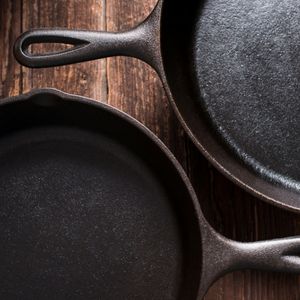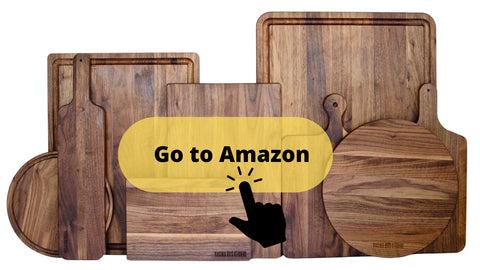A cast iron skillet is arguably the most versatile cookware you can have in your kitchen. That's why it's important to know how to season your cast iron skillet. From the flexibility of stove-to-oven meals, to getting perfectly seared steak again and again, it’s every chef’s dream.
So what do you do when the non-stick qualities seem to be deteriorating? Do you throw it out for a new one? Find out how to make your old skillet good as new with our simple seasoning technique.
What Does Seasoning a Cast Iron Skillet Mean?
Seasoning simply means baking a neutral oil onto the surface of your skillet in a process known as polymerization. Unseasoned cast iron skillets usually have a textured surface that is prone to damage by moisture and air. This surface is usually not non-stick and can be difficult to use in the long run.
Why Should You Season a Cast Iron Skillet?
Baking carbonized oil onto the surface of a skillet at high temperatures changes it from its liquid form. Then, the oil bonds with the iron to create a protective non-stick layer. Fortunately for modern home cooks, most cast iron skillets come pre-seasoned and ready to use from the manufacturer. However, this small perk doesn’t mean you can’t go over with another layer of seasoning just to be sure.
How to Season a Cast Iron Skillet
Seasoning your skillet is surprisingly easy even for the beginner cook. For the most part, most cooks go their entire lives without having to season their skillets. This is because the grease continues to build up on the pan over time, thus improving the quality of the pan. However, if acidic foods make a constant appearance on your pan, it may deteriorate much quicker than others. Here’s how to go about seasoning your cast iron skillet.
Clean Your Skillet
Cleaning your skillet is perhaps the most important preparation step when it comes to seasoning your pan. This step may be a breeze through the park if you’re working with a new pan. However, a pan that’s old, rusty, and full of food residue may need extra care. After all, nobody wants to be wondering what the gunk in the skillet might be a few months later.
To clean your skillet, use warm water, a little dish soap, and a sponge to scrub away the food residue. You can also use this natural cast iron scrub with walnut husks and essential oils to help you scrub off all the particles without damaging your skillet. After cleaning the skillet, dry it properly with a cloth before placing it on the stovetop on low to dry completely.
Oil Your Skillet
Once the skillet is cool and safe to handle, grab a neutral oil like vegetable, grape seed, or canola oil and apply it all over the skillet including the sides, bottom, and handle.
Use just enough oil to ensure the pan is completely coated but not wet to the touch because any pooling may result in stickiness. Of course, that stickiness takes away from the non-stick quality. A vegetable shortening can also be used in this step.

A Note About Butter and Olive Oil
As a creative chef looking to make the most out of flavors, you may wonder whether butter and olive oil are good alternatives for seasoning. While we can’t deny their distinct tastes in every meal they grace, using these oils may have some downsides.
Butter has a very low smoking point and is high in saturated fats. This simply means butter will burn quickly and completely ruin the process. If you're careful, you may be able to pull it off if you follow our guide for how to use butter to season cast iron.
Olive oil, on the other hand, is a great oil however its flavor profile is a bit too advanced to narrow it down to just a seasoning oil and would ultimately be a waste. To add to that, you would have to go the extra mile to find refined olive oil as extra virgin oil has a lower smoking point than what you need for seasoning. Still, if you find yourself needing to go that route, check out our guide for how to season cast iron with olive oil.
All in all it’s just not worth the work. Just remember to use an oil with a high smoking point to avoid kitchen disasters.
Place Your Skillet in the Oven
Place a sheet of aluminum foil on the lower rack of your oven and set it to 350°F. Then, place your skillet in the oven upside down on the upper rack. The aluminum foil beneath it should collect any oil drippings. Bake the skillet in the oven for an hour and then turn off your oven. Leave the skillet to cool overnight.
Always try to schedule your seasoning on a day that you won’t be needing your oven. Having a smoking hot skillet lying around in the kitchen could cause accidents. Once your skillet has cooled, you can inspect it to see whether it is properly seasoned. If you have a few missed spots, you can repeat the process until you are satisfied with the results.
Variations in Seasoning Process
Described above is the most popular way to season a skillet. However, some people swear by the stovetop seasoning technique. While it may work for an experienced cook looking to get the process done quickly, it may be tricky for beginners. This method involves an uneven distribution of heat that creates hot and cold spots which may lead to a very uneven seasoning.
Final Thoughts
Ultimately, seasoning your cast iron skillet doesn’t have to be a headache. Within just a few hours you can go back to enjoying great meals without a care in the world. However, for a process that renders your oven unavailable for over 10 hours, you may not want to do it too often.
To maintain your skillet in peak condition, a proper seasoning oil is worth the investment. You can simply rub this oil all over your pan after every wash to protect it from moisture, rust, and dirt build-up. We hope this article helped save a perfectly good pan from ending up abandoned at the landfill. Happy cooking!
RELATED PRODUCTS YOU MIGHT LIKE
See our full collection of wood and cast iron care products including our plant-based cast iron scrub and cast iron oil for optimal cast iron care.
See Virginia Boys Kitchens On Amazon
We are on Amazon, see our storefront here. Use coupon code VBKBLOG10 for 10% off your entire purchase of any Virginia Boys Kitchens on Amazon. Apply the code at checkout.




